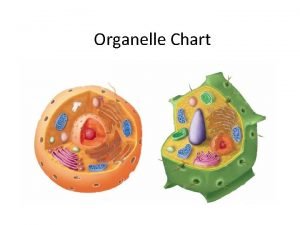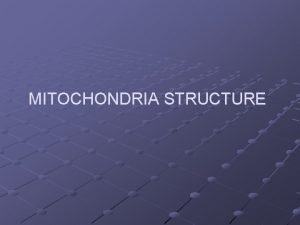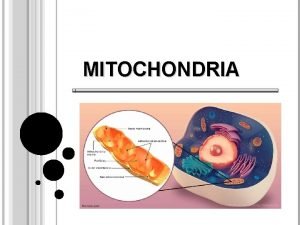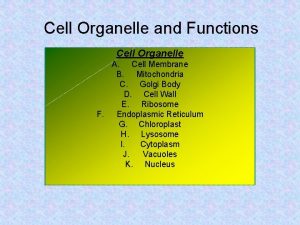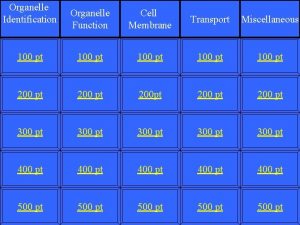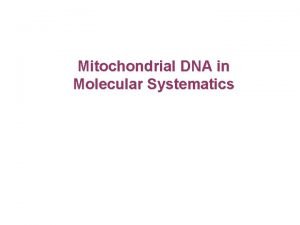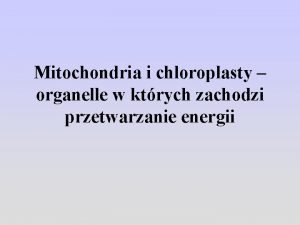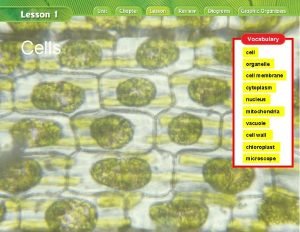MITOCHONDRIA 1 2 3 Mitochondria The organelle that












- Slides: 12

MITOCHONDRIA 1

2

3


Mitochondria The organelle that releases energy in the cell. (The powerhouse of the cell) • Only found in ANIMAL cells. • Mitochondria produce ATP using energy stored in food molecules. Mitochondria are the primary energy producers in cells.

Structure � Mitochondria have a double membrane structure There is a single outer membrane and a folded inner membrane � Sac with two inner compartments which are separated by the inner membrane. � The first compartment is between the outer and inner membranes. � The outer compartment is inside the inner membrane. 6

� The outer mitochondrial membrane is composed of about 50% phospholipids by weight and contains a variety of enzymes involved in such diverse activities as the elongation of fatty acids, oxidation of epinephrine (adrenaline), and the degradation of tryptophan. The inner membrane contains proteins with three types of functions. � Those that carry out the oxidation reactions of the respiratory chain have ATP synthase, which makes ATP in the matrix and specific transport proteins that regulate the passage of metabolites into and out of the matrix. 7

Functions � � � Mitochondria are the sites of most of the energy production in eukaryotic cells. They use complex molecules and oxygen to produce a high energy molecule known as ATP (Adenosine Triphosphate) in a process called aerobic respiration. Energy production the mitochondria has been called the "powerhouse of the cell". Mitochondria are very abundant in cells that require lots of energy. Eg: - Muscle 8

Unique Characteristics: Mitochondria are very unique in several regards �have their own circular DNA �have their own Ribosomes. (The DNA in the cell nucleus does not code for the construction of mitochondria. ) All the mitochondria in your body comes from your mother. � Mitochondria are not part of the genetic code in the nucleus of your cells. � 9

� Fathers only give genes to their children. � Mothers give genes and cytoplasm to their children in their egg cells. � Since mitochondria are in the cytoplasm and reproduce themselves they only are inherited from mothers. � Geneticists have used this curious feature of mitochondria to study maternal family lines and rates of evolution. 10

� � � � Although the primary function of mitochondria is to convert organic materials into cellular energy in the form of ATP, mitochondria play an important role in many metabolic tasks, such as: Apoptosis-Programmed cell death Cellular proliferation Heme synthesis Steroid synthesis Heat production (enabling the organism to stay warm). Some mitochondrial functions are performed only in specific types of cells. For example, mitochondria in liver cells contain enzymes that allow them to detoxify ammonia, a waste product of protein metabolism. A mutation in the genes regulating any of these functions can result in a variety of mitochondrial diseases. 11

Thank you QUERIES WELCOME
 Mitochondria organelle facts
Mitochondria organelle facts Thơ thất ngôn tứ tuyệt đường luật
Thơ thất ngôn tứ tuyệt đường luật Tôn thất thuyết là ai
Tôn thất thuyết là ai Phân độ lown
Phân độ lown Walmart thất bại ở nhật
Walmart thất bại ở nhật Gây tê cơ vuông thắt lưng
Gây tê cơ vuông thắt lưng Block xoang nhĩ là gì
Block xoang nhĩ là gì Tìm vết của đường thẳng
Tìm vết của đường thẳng Sau thất bại ở hồ điển triệt
Sau thất bại ở hồ điển triệt Thể thơ truyền thống
Thể thơ truyền thống Hãy nói thật ít để làm được nhiều
Hãy nói thật ít để làm được nhiều Các số nguyên tố
Các số nguyên tố Thiếu nhi thế giới liên hoan
Thiếu nhi thế giới liên hoan
